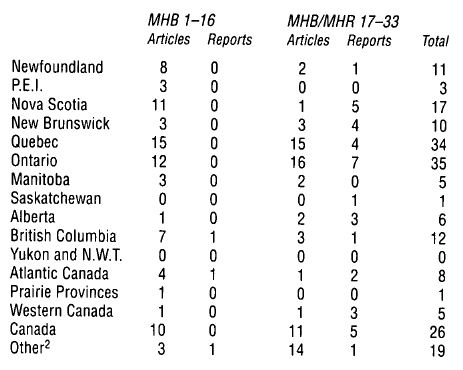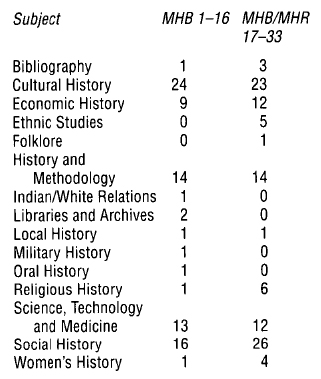Research Reports / Rapports de recherche
Charting the Changes:
An Index to the Material History Review
1 This report has been developed from a paper presented as part of a directed studies course in the M.A. program in Canadian Studies at Carleton University.
2 The contents of the first 33 issues of Material History Bulletin, now Material History Review, were indexed to form a database. Using searchable fields on the database, an attempt was made to analyse the contents of these issues. In order to note trends which may have occurred in the content of the refereed articles, they were analysed from the perspectives of language, geographic subject, and general subject content. A comparison was made between the contents of issues 1 to 16 and issues 17 to 33. This dividing line was chosen because Peter Rider's article in issue 20 surveyed the contents of issues 1 to 16.1 Although the total number of items indexed was far greater for issues 17 to 33, there are actually more refereed articles in the first 16 issues —79, compared to 77 refereed articles in issues 17 to 33.
3 Because the research reports are often substantial, it was decided to also analyse them by language and geographic area; they totalled three in issues 1 to 16 (all, coincidently, in issue 14) and 39 in issues 17 to 33. In the printed and online indexes, specific subjects will be found for each entry. For this analysis, it was decided to use the listing provided to describe the contents of America: History and Life, which indexes approximately 2100 journals, and is available in print or online. The listing of subjects used is taken from the "Bluesheet" which briefly describes the contents of each database on the Dialog online search system. The limitations of this list revealed the lack of a few topics which might merit a separate heading, such as art history, business history, labour history. For the purposes of this analysis, art history — including architecture — and decorative arts have been included with cultural history. Business history and labour history have been included, as appropriate, with economic history, social history, or science, technology and medicine.
4 The language analysis of refereed articles/research reports is as follows:
In the first group, MHB 1 to 16, the language analysis shows 20 per cent French-language articles plus reports, and 80 per cent English, while in the second group the French-language portion is only 13 per cent of the total, versus 87 per cent English.
5 The number of articles included in the geographic analysis is based on the assignation of geographic subject areas to an article. Some have no geographic subject, such as articles dealing with historiography and methodology in general. This leaves 72 articles from the first 16 issues and 64 from 17 through 33. Two research reports in issues 17 through 33 had no geographic subject. This field includes countries, provinces, and areas, such as Atlantic Canada or western Canada. I have not made a distinction between the Maritime provinces and Atlantic Canada, choosing to use the latter term only. Western Canada includes all four western provinces, and Prairies include Manitoba, Saskatchewan, and Alberta. Articles may include more than one province; except in cases like the general term Atlantic Canada, two or more provinces in one article are counted separately.
6 The following is the geographic analysis:
A few details should be explained. Some articles deal with more than one province or country. And most of the articles whose subject is the United States or a European country are found in MHB 31, papers from an international conference on the history of textiles.2
7 A further consolidation shows regional representation. The next chart compares totals of articles and research reports for the four Atlantic provinces plus Atlantic Canada, the four western provinces plus the Prairies and western Canada, and Quebec and Ontario.
8 Looking at the Canadian geographic distribution, some interesting observations can be made. The most obvious are the absence of articles from Saskatchewan, except as part of western Canada and the Prairie provinces, and from northern Canada, and also an abundance of items from Atlantic Canada, especially Nova Scotia, in the first half.
9 Perhaps the omission of northern Canada can be partly explained by the decision, recently changed, to exclude articles of an ethnological nature, thus eliminating topics dealing with Canada's aboriginal peoples. Europeans often find these to be the most interesting material cultures in North America.3 Perhaps the colloquium on Atlantic Canada and the theme issue on furniture raised the proportion of articles from Atlantic Canada in the first 16 issues. The Prairie provinces are underrepresented; even the inclusion of the theme issue on Ukrainian culture, MHB 29, in which articles deal with western Canada, did not make a large impression on the overall statistics. British Columbia was well represented in the first 16 issues, at a time when one of the editors resided there.
10 While the number and percentage of articles written in French declined, the number dealing with Quebec remained the same, leading to a higher percentage. Some English-language articles have Quebec as their subject, but there are no French-language articles dealing with other provinces.
11 A larger percentage of articles, 17 per cent for issues 17 to 33 compared to 9 per cent for issues 1 to 16, did not deal with any particular geographic area; likewise, a slightly larger percentage, 17 per cent versus 14 per cent related to Canada as a whole. While these statistics do not include exhibit reviews, I would like to mention, lest the outlook seem too bleak, that eastern and western Canada are well represented in that particular category.
12 The third analysis is by general subject, and covers refereed articles only. Each article is assigned at least one such heading, some have two, rarely does an article have three. Some articles obviously fall into two categories, those dealing with socio-economic conditions, for example. In other cases it is more a judgement of the indexer.
13 The following is the data for this section of the analysis:
For issues 1 to 16, I assigned 84 subject headings to 79 articles, while for issues 17 to 33, I assigned 102 headings to 77 articles. This reflects more complexity in the nature of articles. In the second group there are fewer articles which deal with particular types of objects and more which look at objects from more than one perspective. The topic "ethnic studies" comprises solely five articles from the theme issues on Ukrainian Canadians. With editorial policy on the issue of ethnic material undergoing a change, future issues may have more articles.
14 Some additional explanation of the subjects is in order. Cultural history includes in its purview architecture, art history and decorative arts, as there is currently no "art history" category. In light of recent editorial board decisions to expand the scope of Material History Review, such a category may be added for a future analysis. The category of science, technology and medicine stresses the technology aspect; most of the articles in this category deal with industries. While the absence of the science portion of the category is not surprising, minimal representation of the medicine part is, as some type of medical apparatus, however rudimentary, would likely have existed in most communities. Quite a number of research reports and notes deal with cemeteries and gravestones, perhaps an indication of the scarcity of medical tools and skills. Finally, this may be a sign of our times: of those articles on women's history, all but one describe women in the workplace, rather than in a domestic setting.
15 Is there any correlation between allocation of government funds to cultural spending in various parts of the country and the number of articles people are able to contribute to journals such as the Review? If funds are cut, then museum staffs are likely reduced, and those who are left have far more work to do towards the daily operation of their museums. It will certainly be interesting to see what changes the expansion in subject coverage will have on the Review's next sixteen issues, and whether there are more contributions from those areas of the country previously underrepresented.



